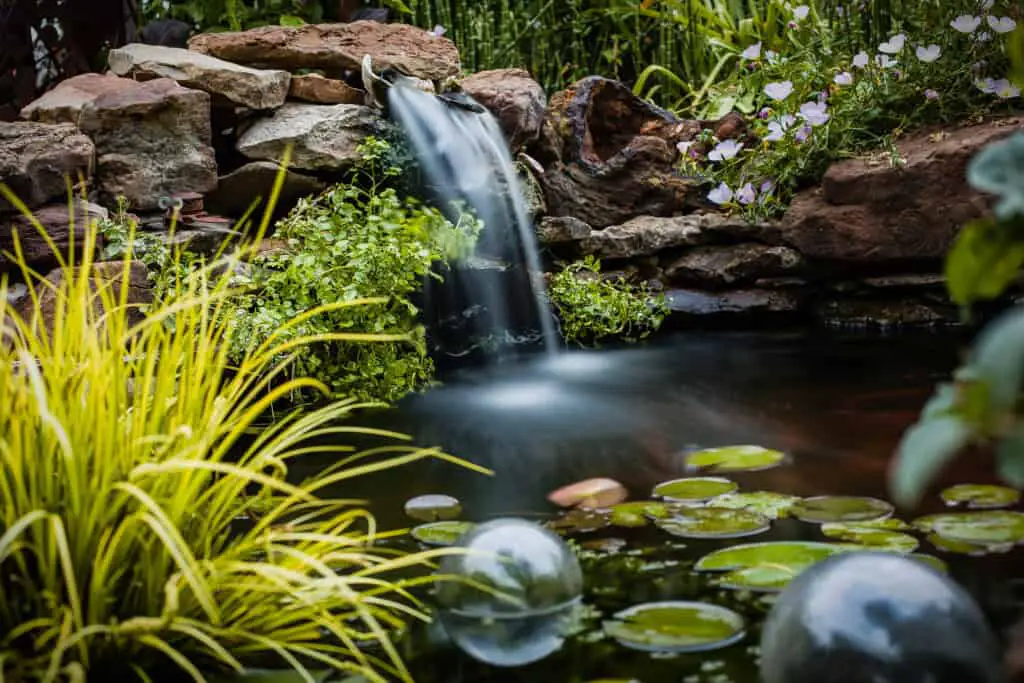
In 19th century Japan, farmers began keeping koi fish in their rice fields as a food source and for their aesthetic beauty. Fast forward to the 21st century, keeping koi is a global sensation. Koi are used to decorate a range of venues in spectacular ponds with unique tile patterns to tropical jungle designs. A huge attraction of these ponds is usually a waterfall. But are these water features unnecessarily excessive, or should you put a waterfall in your koi pond?
Although a waterfall is not critical for a koi pond, adding one brings many benefits. Many recommend adding a waterfall to your pond if you have the capacity for it. Koi require clean, oxygenated water, and waterfalls assist in aeration and circulation. They also add aesthetic appeal.
Although adding a waterfall to your koi pond is beneficial, whether you should add a waterfall to your koi pond depends on several factors. Do the benefits outweigh the drawbacks? Can you afford it? How easy is it to maintain? Do koi fish like waterfalls? And what type of waterfall is best for koi ponds?
Pro Tip: If you’re tired of wasting money and making costly mistakes on the koi-keeping hobby or are thinking about buying koi fish but don’t know where to start, I strongly suggest you check out this ebook. I recently read this ebook, and it contains SO much useful information, such as:
- 3 proven steps to identify koi fish diseases
- WARNING: 3 things you should NEVER do when it comes to caring for koi
- When to seek professional help when it comes to looking after your koi
The Reasons Why You Should Put A Waterfall In Your Koi Pond
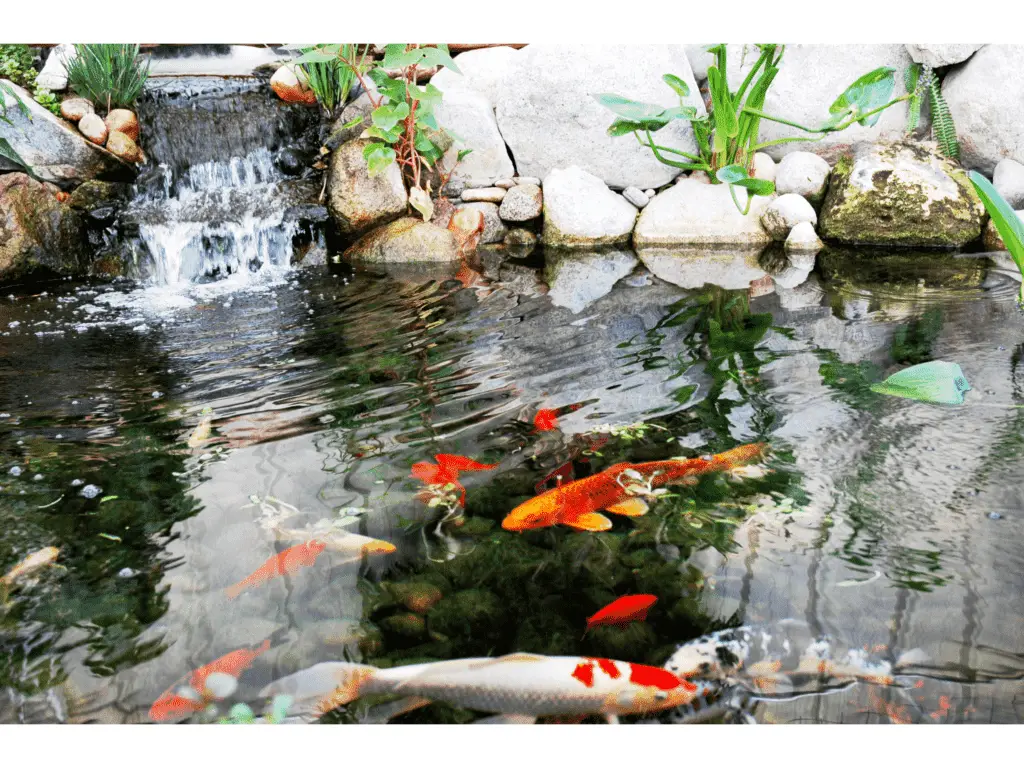
Most koi ponds bring peace, solace, introspection, and a dash of elegance to the area where they are established, and some are even enchanting in their design. Whatever your need, a koi pond is a great addition, and ponds that incorporate running water, or a water feature of some sort, are the ponds that truly shine.
Waterfalls provide a range of benefits like oxygenation, circulation, aesthetic enhancement, enrichment for koi fish, and many more.
If you’re deliberating as to whether to add a waterfall to your koi pond or not, let’s look at things from your koi’s perspective:
Do Koi Like Waterfalls?
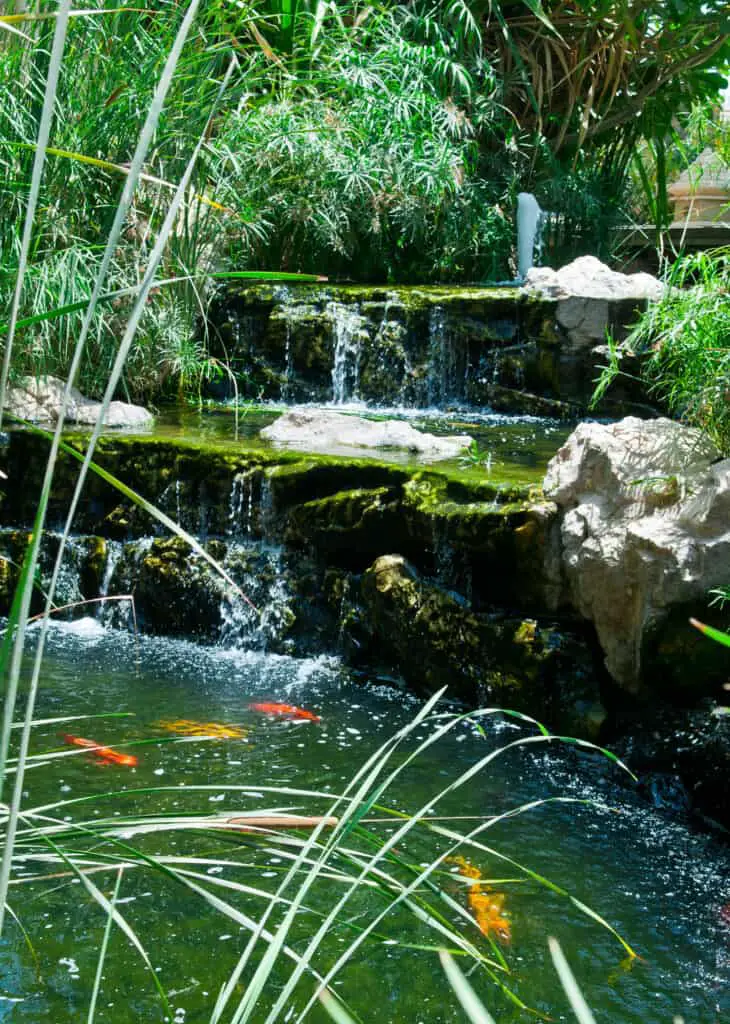
Although it is challenging to say if a fish “enjoys” something or not (their brains don’t function quite like our brains), koi fish tend to aggregate around waterfalls, which means they may have an affinity for them (and moving water in general).
- Waterfalls provide koi with many benefits, including a place to hide. The ripples created by waterfalls disturb the water’s surface, obscuring predators’ vision.
Birds (like herons or kingfishers) are avid hunters of koi, so adding hiding places to your pond is a critical management tool.
Koi are drawn to waterfalls for many other reasons.
- Waterfalls break the surface tension and act as an “interesting” distraction that may potentially offer food.
- Waterfalls improve the pond’s conditions by increasing the dissolved oxygen levels, creating a current, and maintaining pond homeostasis.
Why Do Koi Sit Under Waterfalls?
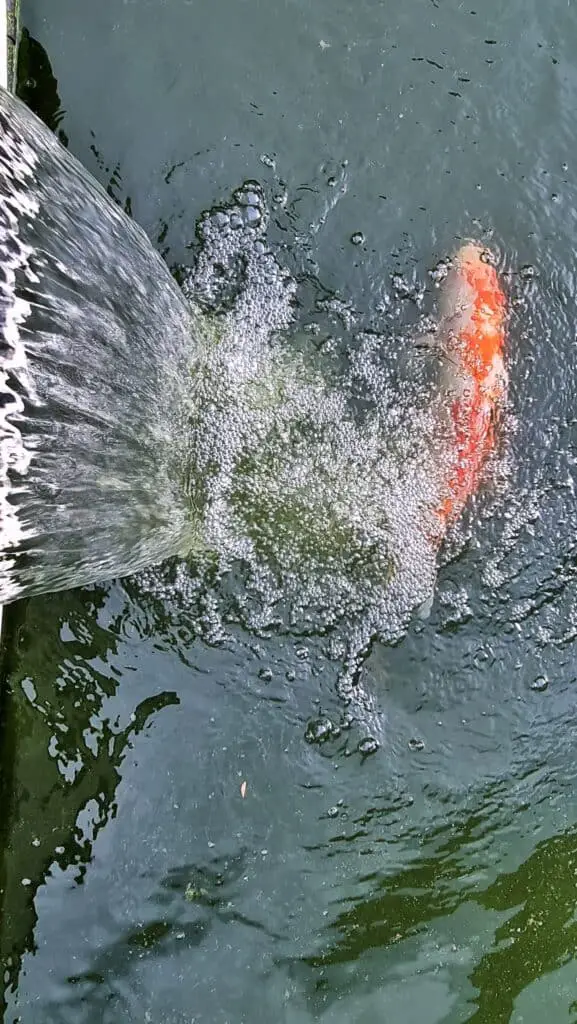
Koi sit under waterfalls for numerous reasons. However, it often indicates that something is not right in your pond.
- If koi spend extended periods around or under your waterfall, it may indicate an oxygen shortage in your pond. If you don’t have an aerator and only rely on your waterfall for oxygenating your pond, you should consider purchasing one in this instance.
- If there is an algal bloom, harmful bacteria, excess organic waste, or other hazardous chemicals in your pond, koi may also migrate and reside under the waterfall.
Regular checks and maintenance of your koi pond, pumps, and filters will avoid most of these problems. If any unpleasant conditions develop in the pond, it may indicate that some of the equipment is no longer functioning optimally and needs to be cleaned, repaired, or replaced.
If your koi are aggregating around the waterfall, don’t panic! Distressed koi generally indicate they are unwell by excess “flashing,” gaping, swimming in irregular patterns, and other visual and behavioral displays. If these indicators are absent, chances are, your koi are okay and are around the waterfall for another reason.
The other reason why koi fish aggregate under a waterfall is related to food.
Some waterfall designs consist of several pools where water cascades down. If frogs or insects accumulate in the upper pools and spill over, your koi will flock to the food source.
Most critical is to monitor your koi for parasites, low oxygen behavior, or any other indicative signs that there may be issues in your pond.
The Benefits Of A Waterfall In Your Koi Pond
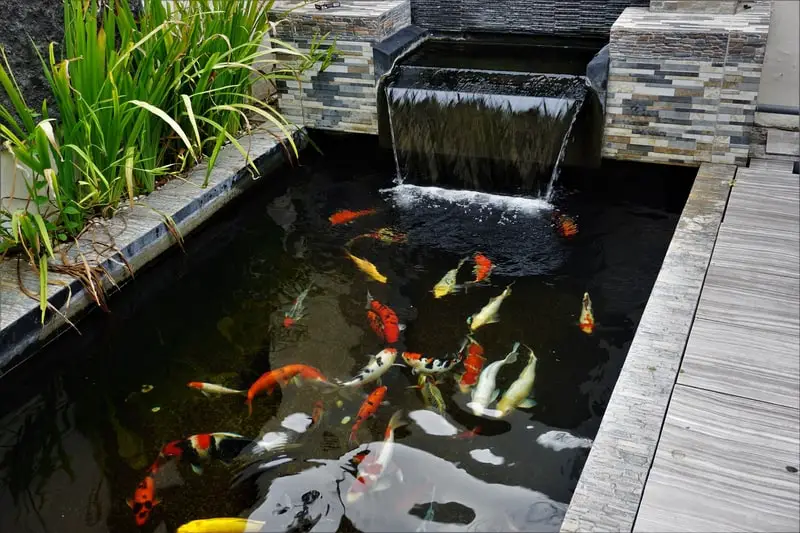
One of the most prominent reasons for adding a waterfall to a koi pond is it is incredibly aesthetically pleasing. We keep koi because they look nice and provide us with a sense of peace and tranquility (most of the time, at any rate).
Adding a waterfall increases this serene scene and brings solace to our backyards.
A koi pond can look “magical” or incredibly sophisticated when well-constructed, suiting your independent needs.
Aside from the fantastic aesthetic appeal, pond waterfalls add some functional benefits to koi ponds.
Waterfalls Act As An Aeration Device
The most significant advantage of a waterfall in your koi pond is that the waterfall aerates (and therefore oxygenates) your pond.
Water from the pond is sucked through pipes to the top of your waterfall. Once there, water makes its way down the waterfall. As the water cascades, oxygen molecules bind to water droplets.
These oxygen-bonded water drops slam into the pond water, releasing the oxygen molecule into the water body and aerating the water.
The greater the descent and volume of the water cascading down the waterfall, the greater the amount of aeration.
An aerated pond is a healthy one, and koi fish benefit tremendously from adding a waterfall.
Waterfalls Promote Water Circulation
Waterfalls assist pond circulation in two ways. The pump that sucks water through the pipes which lead to the top of the waterfall causes a pulling motion, while the impact of the water itself “slamming” back into the pond displaces standing water.
This circulation further promotes oxygenation, better filtration, and assists in maintaining the pond.
When organic matter (e.g., leaves) falls into the pond, they float for a period and then sink. Once on the bottom, they become points for algal and bacterial growth. By circulating water, waterfalls push floating organic matter to the pond’s edge, where you can take it out before it sinks.
Waterfalls Prevent Anaerobic Decomposition
While waterfalls contribute to the pond’s water circulation and push floating organic material to the edges, waterfalls also promote effective decomposition.
Waterfalls cause a disturbance of the substrate and water up to 6 feet deep (depending on the size of the waterfall and pond).
As the water circulates, subsurface organic matter is disturbed, fragmented, and redistributed. These actions are critical as stagnant organic matter begins to decompose anaerobically over a longer time.
Anaerobic decomposition releases awful-smelling gasses, resulting in your pond developing an off-putting smell. Aside from bad odors, anaerobic bacteria (and other microorganisms that thrive in zero oxygen environments) can make your koi sick.
Reducing these microbes (through better aeration) decreases the risk of koi getting sick.
Proper circulation and the associated decomposition are essential for a healthy pond and koi fish.
Waterfalls Provide A Buffer Against Noise Pollution
The sound of running water is dramatic, soothing, enchanting, and thought-provoking at the same time. A waterfall addition looks (and sounds) fantastic, giving the pond a greater natural sound.
An additional benefit is that a waterfall’s delightful sound also provides a noise “screen” against the daily ambient noises of life.
I.e., if you live in an area with traffic, construction, a school, or any other pervasive noises, a waterfall’s audio contributions “drown out” those other sounds, resulting in your garden becoming the perfect escape from the world outside.
Waterfalls Provide Enrichment For Your Fish
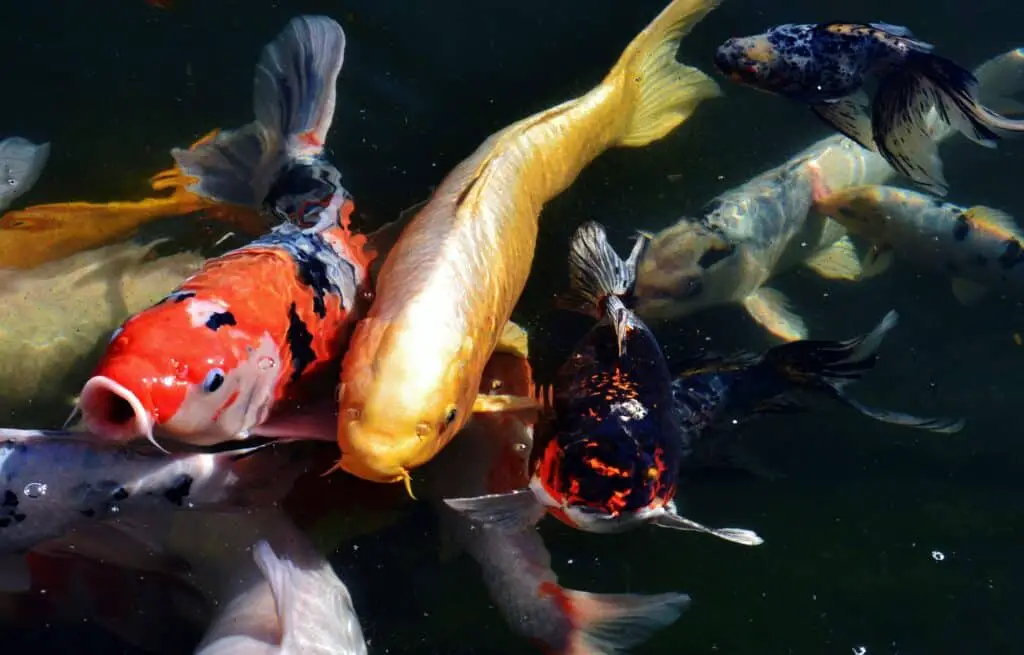
Waterfalls introduce a different dynamic to an otherwise stagnant pond surface. Waterfalls break the pond’s surface, which initiates your koi’s instinctive reaction to investigate. This curiosity factor, coupled with the current generated providing resistance for koi to swim against, waterfalls are great for enriching your koi.
Waterfalls also occasionally catch a bug or frog, which cascades with the water into your pond. Koi are voracious consumers of most things that fit into their mouths, so a misfortunate frog or bug riding the water chute will probably become a snack.
Waterfalls Contribute To A Pond Ecosystem
The presence of a waterfall in your koi pond is beneficial to koi fish and the pond ecosystem as a whole. Surrounding plants receive spray, moisturizing their leaves. The current generated also promotes stronger root development, as plants must hold on more securely against the water pressure.
The sound of moving water may also attract frogs and other critters to your pond, further enhancing the ecosystem. The more natural a pond becomes, the greater the appeal to aquatic fauna and flora.
Waterfalls Help To Regulate Pond Temperature
During the summer, a waterfall assists in reducing the temperature of the pond. While water cascades down the waterfall and picks up oxygen molecules, the water droplets are cooled down/lose heat. They strike the water and displace the warmer water, cooling the pond.
There are different strata (layers) of water within a pond (and most water bodies), there are different water strata (layers), and cooler water is usually at greater depths. Waterfall pumps suck water from this colder band and release it down the waterfall. This cooler water hits the top and sinks downwards, cooling off the top layers as it goes.
The Cons Of A Waterfall In Your Koi Pond
Although the benefits of adding a waterfall to your koi pond are tremendous, there are some downsides to a waterfall and some limitations to its effectiveness, which we address below.
Waterfalls Don’t Work In Frozen Water
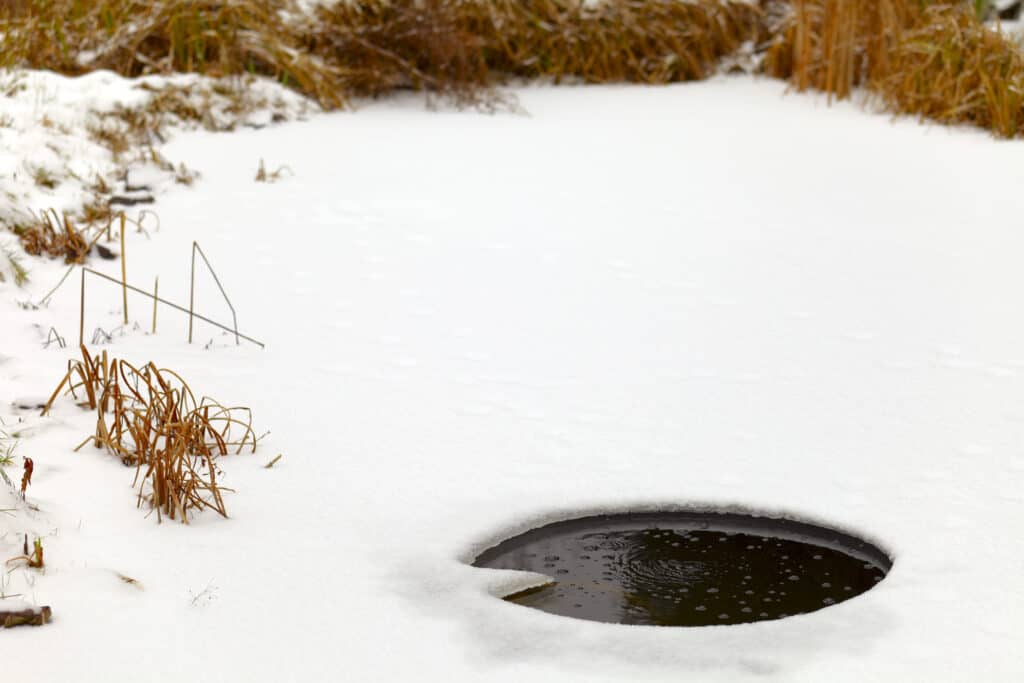
A bubbler is necessary to aerate your pond in areas that experience lots of ice and freezing winter temperatures.
Although outside koi survive under the ice (provided the pond is deep enough), they require air. A waterfall will not work and becomes less effective during the winter, so a bubbler, or other water aeration, is necessary.
Waterfalls May Not Oxygenate Your Pond Sufficiently
The most significant downside to a waterfall is that they generally do not provide your pond with enough oxygen on its own.
In smaller ponds, a waterfall might be sufficient to aerate the water; however, koi require larger ponds, meaning the waterfall will need to be substantial in size to provide enough oxygen. Most of us cannot afford a one-story high waterfall and need to opt for an additional aerator (such as a bubbler).
Waterfalls may also be insufficient in “mixing” or circulating your pond efficiently. Depending on the depth and size of the pond, a waterfall may not move enough water to make it effective in circulating. This lack of effective circulation results in the water around the waterfall becoming well oxygenated, but the rest of the pond remains oxygen-poor.
Factors that further limit a waterfall’s ability to oxygenate your pond sufficiently include:
- The degree of organic waste buildup. If there is too much organic waste buildup, waterfalls may not be sufficient to oxygenate the water. Algae use dissolved oxygen in the water, and as waste builds up, algae begin to bloom.
- The number of koi also impacts how effective a waterfall is. More koi means more dissolved oxygen extracted from the water. A waterfall might effectively keep small koi numbers well-oxygenated, but as numbers increase, the efficacy decreases.
- The size and depth of your pond. Ponds over six feet deep require additional underwater filters/bubblers to circulate and aerate the water effectively. Waterfalls tend to move the top layer of water but are not strong enough to shift water lower down.
This circulation dichotomy results in stagnant water and a buildup of organic matter. These conditions lead to anaerobic decomposition.
Waterfalls Are Not Sufficient Pond Filters
No matter the size of your waterfall, a filter is still necessary. Although waterfalls remove some organic matter from the pond while pushing floating organic matter to the edges for easy retrieval, they cannot remove all of the organic matter.
Therefore, a filter is necessary to ensure clean pond water and healthy, happy koi fish.
Waterfalls Increase The Cost Of Your Koi Pond
Buying or making a waterfall water feature could become costly (especially if you did not factor it in before starting your koi pond). Depending on the size, design, layout, materials, and labor, a waterfall could cost roughly $450 to $1000.
Making a waterfall yourself could be cheaper, but the time and effort needed may not be worth the investment.
Aside from the initial purchase, waterfalls cost money to run and maintain.
Waterfalls Require Electricity To Operate
Unfortunately, you’ll need electricity to run your waterfall’s pump unless you connect your waterfall to a stream.
A waterfall, a pond filter, and an aerator (bubbler) all need electricity; after a month’s operation, your wallet will feel the difference. Although a waterfall is nice and provides benefits, you need to factor running costs into your monthly expenses.
Waterfalls Require Additional Maintenance
If you want your waterfall to last, you’ll need to regularly clean and maintain it.
Some routine maintenance includes:
- Pipes and outlets become blocked by organic matter, and you’ll need to clean them out.
- Pipes and components break during use, and you’ll need to replace them.
- Pipes freeze and burst during the winter. A broken pipe needs replacement.
- Pumps burn out with use, especially if the pump is incorrectly suited to your pond.
- Electricity surges (from lighting strikes or bad grids) may damage pumps. These pumps need repairs or replacement.
Checking to see any leaks, malfunctioning units, or other clear signs of not functioning optimally is critical to prevent a repair job from becoming a replacement part.
Waterfalls Can Potentially Make A Mess
Depending on the height of the waterfall and the volume of water cascading, you may end up with a great deal of water splashing out of your pond.
This splashing is not ideal if your pond is close to a building, pathway, or area that may produce mud.
Aside from making a mess, when water splashes out, it reduces the amount of water in the pond. Over time you’ll need to top up your pond or risk running low on water.
Waterfalls Require Additional Space
Waterfalls tend to be large, and even smaller models require additional space. If you have a smaller yard, then this may not be ideal. Waterfalls are also incompatible with aquariums (in most cases, there are elaborate aquariums that accommodate many additional features).
Planning where your pond is located is essential if you want to add a water feature like a waterfall.
Waterfalls Produce Noise Pollution At Night
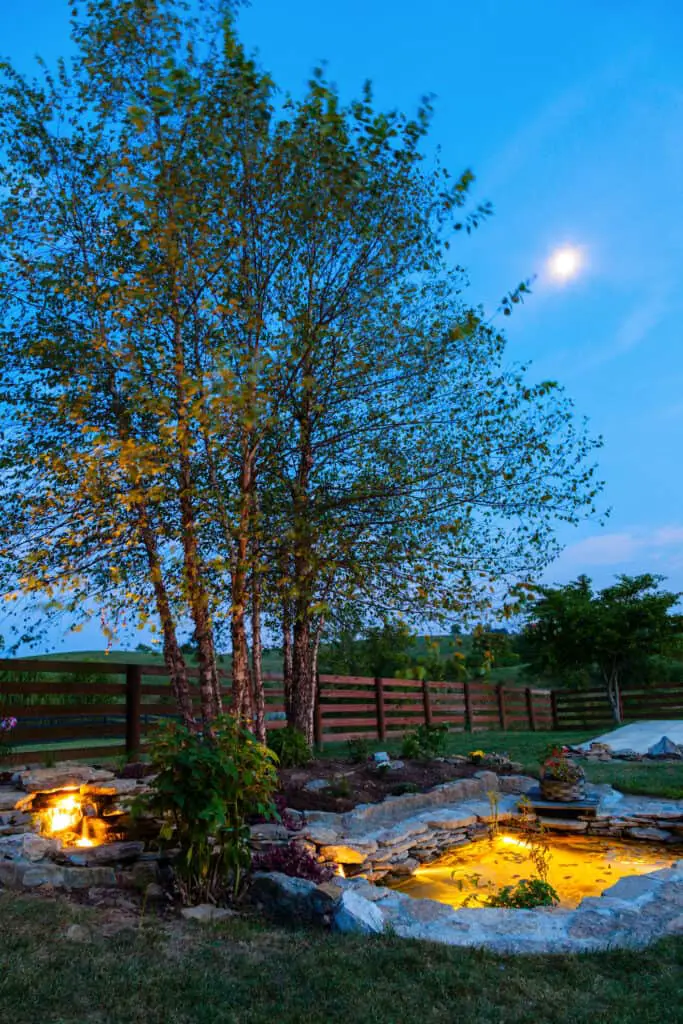
While during the day, the sound of a waterfall mercifully drowns out the ambient noise of the neighborhood, at night, the waterfall may sound “deafening.” Nighttime is usually quieter, and the continuous sound of water splashing might become annoying, especially for your neighbors.
What Type Of Waterfall Should I Get For My Koi Pond?
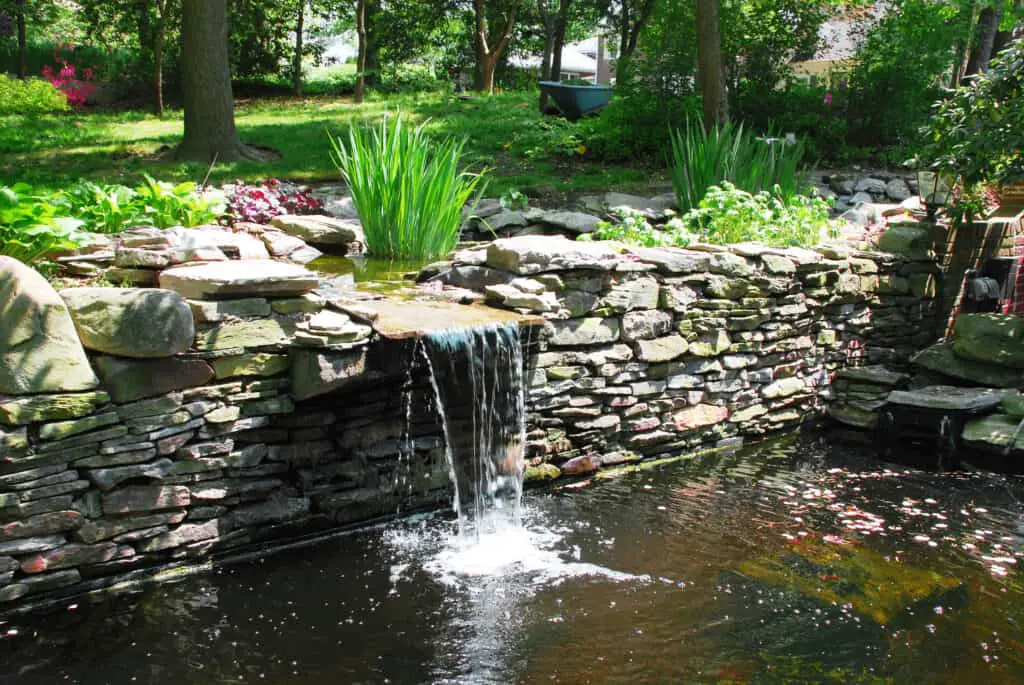
The great part is that no one particular waterfall stands supreme above the rest. A waterfall feature should complement your koi pond’s aesthetics while still practical.
When selecting a waterfall water feature, you can choose a pre-built one that many nurseries sell. These are often great for smaller ponds or those who don’t enjoy too much DIY.
For those more DIY-inclined and who prefer to build your waterfall, ensure that the pump you select is big enough (strong enough) to pump water from the pond up to the top of the waterfall.
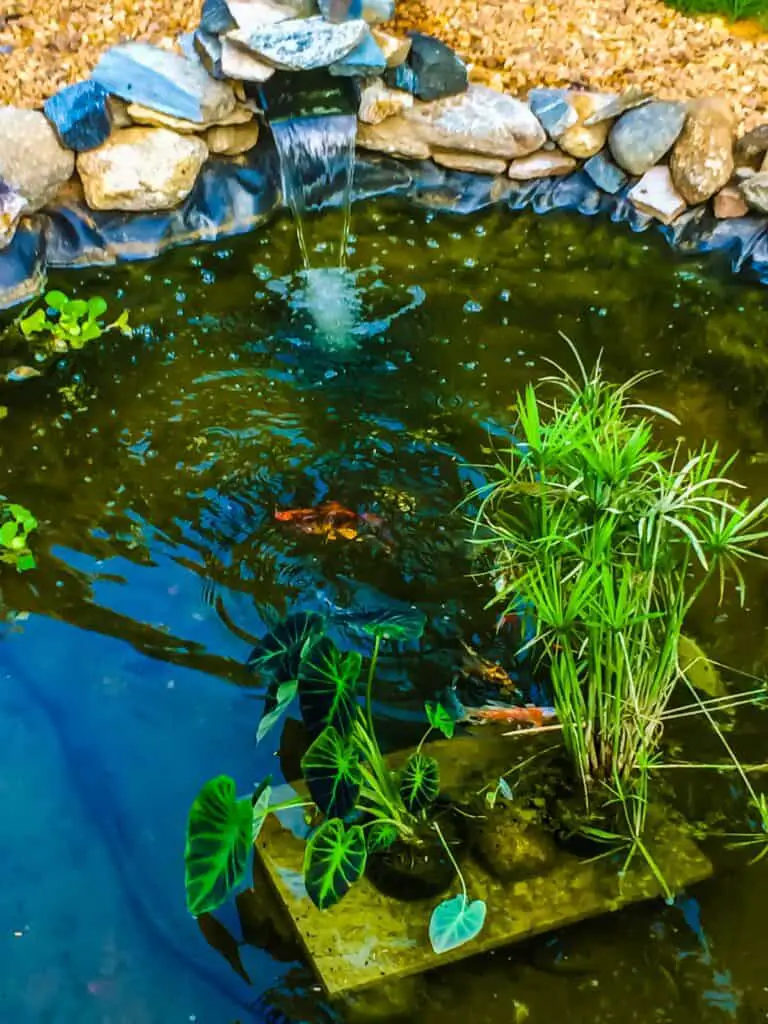

The most critical decision you’ll need to make is choosing the correct sized pump. When selecting a pump, use the following formula, for every inch of your waterfall’s width, your pump needs to pump 100 gallons of water per hour.
This method is the minimum recommendation. If you’d like to put a more powerful pump in to create a bigger water “splash,” then use 200 gallons per inch of width. The recommended rate is around 30 gallons per minute.
To calculate the pump required, multiply your waterfall’s width (in feet) by 30, and this will give you the required gallons per minute (multiply that by 60 to get gallons per hour (GPH)).
The other important factor is the “head height.” When a pump pushes water up the pipes to the top of the outlet (waterfall), it needs to push 8 pounds per gallon of water. The head height(measured in feet) is the distance from the pond water’s surface to where the water pours out of the waterfall.
When selecting a pump, ensure it is designed for this distance and at the correct GPH.
By choosing a too small pump, you’ll overwork the motor, causing it to burn out quicker.
Waterfall outlets come as waterfall spillways or waterfall filters. These outlets are similar in design, and both oxygenate the pond; however, the waterfall filter has a filter system built in to assist in cleaning the water.
You can opt for a waterfall that is completely aesthetic in function (i.e., it is too small to circulate and aerate the pond’s water effectively), but then you can’t expect it to be more than pleasing to the eye.
Factors To Consider Before Getting A Koi Pond Waterfall
Aside from waterfalls, Koi fish have some particular requirements that result in fish declining in health and eventually perishing if not met.
What Do Koi Fish Need To Thrive In A Pond?
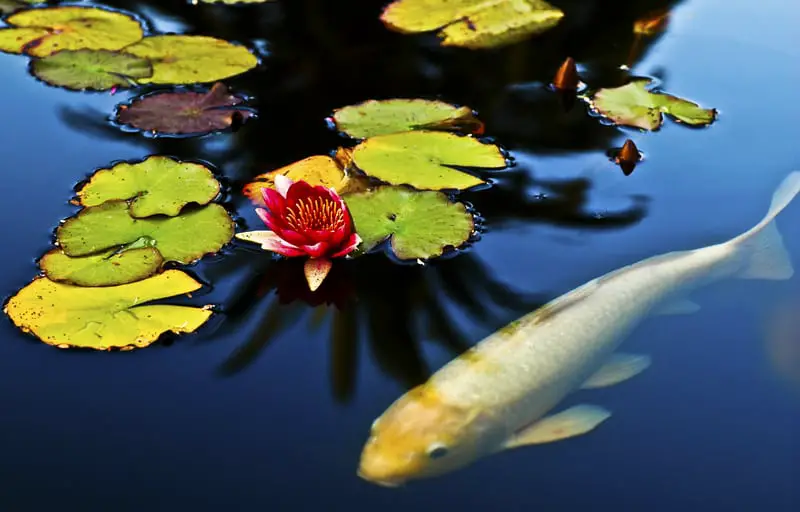
Koi (or Amur carp) fish are hardy fish belonging to the carp family (Cyprinidae). Originating from China, they took them to Japan. The Japanese began breeding with koi (Cyprinus rubrofuscus) and eventually produced the widespread ornamental species we know today.
Many people keep koi in ponds specifically designed for them. These ponds are usually outdoors, but you could keep koi in several different environments.
Koi can live until roughly 100 years old, provided their environment is conducive to this.
To Thrive, Koi Require
- Large ponds. Koi can grow roughly 12 to 15 inches (American breeds), 22 to 26 inches (Japanese breeds), or 34 to 36 inches for Jumbo breeds. Koi require a minimum pond size of roughly 1000 gallons of water.
The minimum measurements for a koi pond are usually 6 feet by 8 feet, with a minimum of 4 feet deep.
- Deep ponds. Four feet is the minimum recommended depth for a koi pond because, in cold weather, koi swim to the bottom of the pond. Deeper water tends to regulate temperature better, so koi survive at the bottom when the top layer freezes over.
- Koi fish require well-oxygenated water. Koi fish need air, which they extract from the water. Without a well-oxygenated pond, your fish will die.
- Koi require a clean pond. Algae and disease go hand-in-hand with dirty ponds. Organic matter, which falls into the pond, leftover food, and waste are examples of things you need to remove from a koi pond. Most ponds have a robust filter system to ensure clean water is the staple.
- Koi fish require the correct diet and volume of food. Too much food goes uneaten and results in organic waste buildup. This buildup promotes algal growth, which, in turn, depletes oxygen levels.
Although koi are a hardy fish from a hardy family, to thrive, their living conditions (the pond) need to be at optimal levels. The great news is that a waterfall assists many of these requirements!
Test Your Waters Parameters
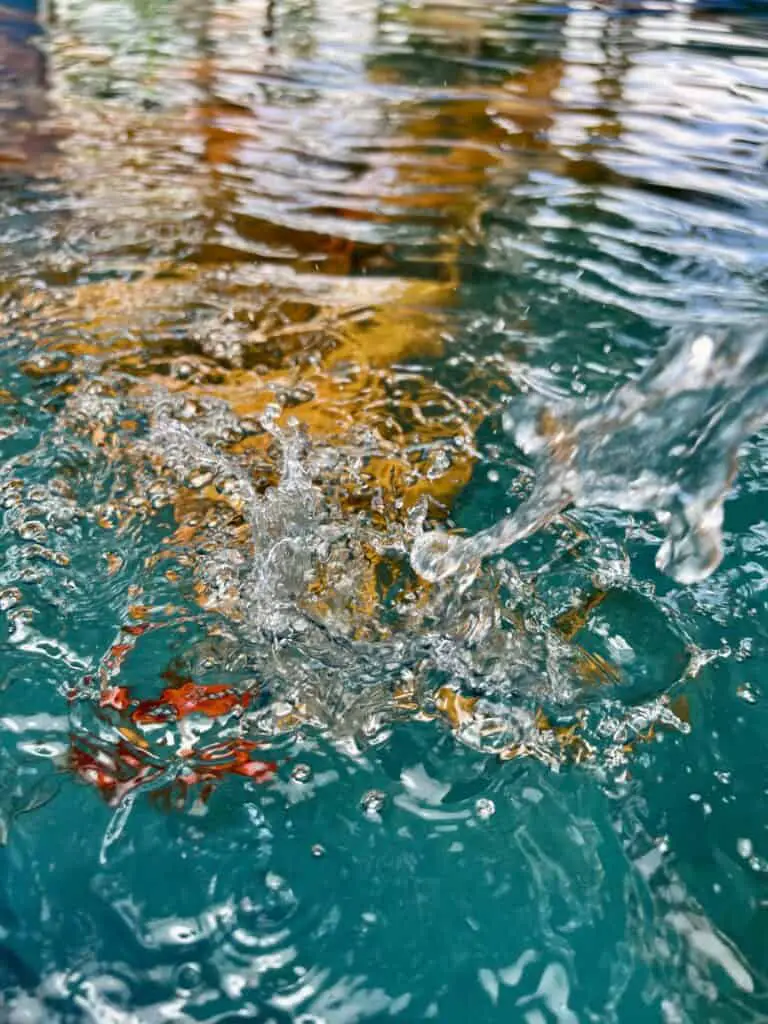
As a waterfall may not provide sufficient oxygen to your pond, you’ll need to check the dissolved oxygen levels of your pond frequently.
Test kits are available from most stores, and they give you an indication of “safe levels” of dissolved oxygen. However, anything less than a rough 6mg/liter (0.00005007lb./gal) is not ideal for your pond’s organisms.
Testing other parameters like acid, total dissolved particles, etc., is also worthwhile, but keeping an eye on dissolved oxygen levels takes priority.
You May Still Need An Aerator If I Have A Waterfall
If your testing shows too little dissolved oxygen (DO), you’ll need to consider purchasing an aerator. These bubblers come in different variations, but all function in restoring the oxygen levels within the water to ideal levels.
Placing a bubbler in your pond during winter is a great way to ensure that koi still have oxygen if the water freezes over.
Conclusion
Waterfalls are a fantastic addition to your koi pond; if you can add one, you should. Waterfalls are aesthetically pleasing but also have the functional benefits of oxygenating and circulating your pond’s water. Koi fish enjoy the moving water and may try to catch food falling down the waterfall. Waterfalls increase the grandeur of your koi pond. They are not without some drawbacks; however, the good outweighs the bad.
References
https://www.petcoach.co/article/koi-ponds-environmental-needs-husbandry-and-basic-care/
https://moviecultists.com/do-koi-like-waterfalls
https://www.familyhandyman.com/project/build-a-backyard-pond-and-waterfall/
https://www.thespruce.com/pond-waterfall-ideas-4171507
https://www.instructables.com/Backyard-Pond-and-Waterfall-No-Experience-Necessar/
https://homeguides.sfgate.com/test-oxygen-levels-ponds-83331.html

